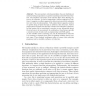Free Online Productivity Tools
i2Speak
i2Symbol
i2OCR
iTex2Img
iWeb2Print
iWeb2Shot
i2Type
iPdf2Split
iPdf2Merge
i2Bopomofo
i2Arabic
i2Style
i2Image
i2PDF
iLatex2Rtf
Sci2ools
ESOP
2006
Springer
2006
Springer
Pure Pattern Calculus
Abstract. The pure pattern calculus generalises the pure lambda-calculus by basing computation on pattern-matching instead of beta-reduction. The simplicity and power of the calculus derive from allowing any term to be a pattern. As well as supporting a uniform approach to functions, it supports a uniform approach to data structures which underpins two new forms of polymorphism. Path polymorphism supports searches or queries along all paths through an arbitrary data structure. Pattern polymorphism supports the dynamic creation and evaluation of patterns, so that queries can be customised in reaction to new information about the structures to be encountered. In combination, these features provide a natural account of tasks such as programming with XML paths. As the variables used in matching can now be eliminated by reduction it is necessary to separate them from the binding variables used to control scope. Then standard techniques suffice to ensure that reduction progresses and to esta...
| Added | 22 Aug 2010 |
| Updated | 22 Aug 2010 |
| Type | Conference |
| Year | 2006 |
| Where | ESOP |
| Authors | C. Barry Jay, Delia Kesner |
Comments (0)

